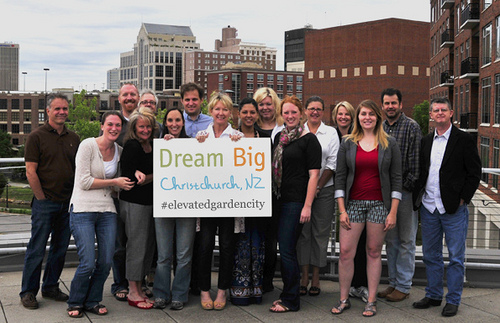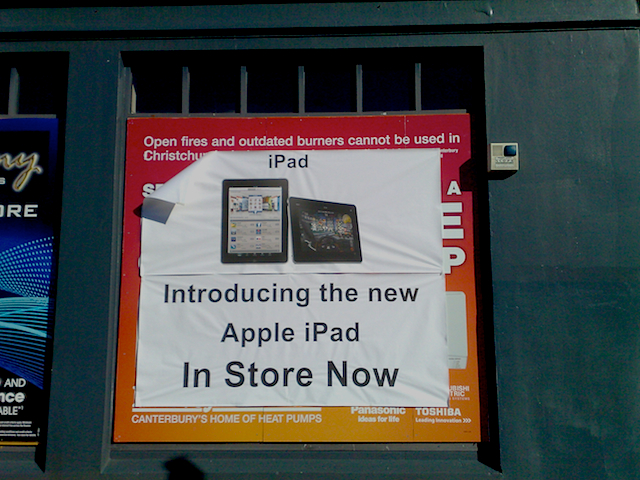This is completely off topic, but in conversations over the last few weeks people have consistently asked me to write this, so here it is. This is about disaster planning and my experience of living through the threat of disaster, and through two actual disasters.
The story begins the week after 9/11. My wife and I were living in London at the time and I vividly recall the Chief of Police giving a statement on television that said it was not a matter of if terrorists would target London, but when. It occurred to me that this was an extraordinary statement, and after giving it some thought I went out and purchased enough food and water for a week.
We left London a couple of years later and never had to use our emergency supplies. On returning to New Zealand I remember seeing a programme on television about the preparation required to live through an earthquake. One of the comments was that you should have a “grab bag” packed with essentials that would allow you to survive for a few days.
Given the London experience I thought this was excellent advice, so in addition to duplicating the food reserves from London, I also prepared a grab bag. This included the usual things (first aid, torches, batteries towels, toilet paper, hand sanitiser etc), along with an encrypted USB stick with scans of all the important paper documentation that would prove identity, insurance and wills. I stored this in the basement right beside the door.
I also bought a Pelican Case to store our backup data as we have ten years of digital photos on hard drives. If you’re not familiar with Pelican Cases, they’re storage boxes that I’m sure are made from the same stuff they use to build airplane Black Boxes. You can put eggs in a Pelican Case and then throw it off a ten metre cliff and the eggs will not break. I thought that was good enough for my data. They are also waterproof to some ridiculous depth. For disaster planning I kept the Pelican Case in my office in case something happened at the house. If you work in IT this is called an off site backup. If you don’t work in IT it’s called a bloody good idea.
In September the unthinkable happened. Christchurch was hit by a magnitude 7.1 earthquake. Bear in mind that Christchurch had not been affected by earthquakes before, and there were no known fault lines under the city.
The damage to our house was luckily minimal, but the grab bag was indispensable. We had no power for 24 hours, no water and questionable sewerage. Luckily it wasn’t long before utilities were back to normal for our home.
However the experience made me re-examine how prepared we were, and I resolved to not only restock what we had used, but also increase the level of preparedness.
I decided that have survival gear in the basement was a bad idea, because if the house collapsed we’d have nothing. We did have a separate garage and I decided that our essential gear should go there. With that in mind I went to a local hardware store and bought the biggest, toughest storage case I could find. I then filled it with tents, sleeping bags, spare cell phone, a water purifier, torches batteries etc.
I also purchased a few more specialty items, but researched these carefully before buying them. I didn’t want to buy cheap, poor quality equipment that would fail when you really needed it. Here’s a handful of the key items:
- the storage case was a builders tool chest. It was from a company called Tyson and I bought it at a hardware store called Bunnings. Tyson make a range of cases and I got the mother-of-all-chests. It is lockable, dust proof, rodent proof and “as capacious as an elephants scrotum.” It’s tough plastic and made in such a way that I reckon that the garage could collapse and it would stay intact. However just to be sure I placed a couple of large cupboards either side of it in the garage (filled with bottled water)
- a wind up/solar torch/radio. You can get these easily at local shops but the quality is usually appalling. I spent a lot of time online and ended up getting a Trevor Bayliss design that had a radio, torch, and a low powered red light (to preserve your night vision and the battery at the same time). It also had a solar panel which would charge the unit in 12 hours. What’s more it has a rubberised outer case which means it’s less likely to break if you accidentally drop it. I tracked down the manufacturer in the UK, emailed a bunch of friends to see if they wanted one too, then bulk ordered ten.
- a wind up torch. I ordered this in New Zealand from a company in Nelson. It’s a pure wind up torch (no radio) that also charges from the mains, and can in turn charge cell phones. It is also water proof to about 10m (all you need) and has two beam strengths (once again to preserve the battery life). As soon as it arrived I plugged it in to give it a full charge.
We distributed this gear around the house in the following way in case of another disaster:
- torches beside the bed to grab immediately
- a small kit by the front door. This also happened to be the strongest point in the house, with three door frames in close proximity. It also had no glass windows around it. The kit by the door included warm clothes for everyone, jackets, more torches, a radio, first aid kit and some water. If we needed to leave the house in a hurry we’d grab this and bolt.
- the grab bag in the basement. This was the next port of call if we needed to evacuate. It had slightly more gear in it and could be carried quickly to the car.
- last stage was the Tyson case in the garage. I also got a sack carrier trolley to go beside the case so I could move it quickly outside as it was too big and bulky for one person to lift.
I figured that would put us in a good position should the unthinkable happen.
The only thing remaining on my list was a pair of handheld walkie talkies. When the earthquake struck in September the mobile phone network went down and I thought that if this happens again the only way to ensure you were in touch with someone was to have your own communications. However I thought this might be a little over the top even for me and delayed spending the NZ$330.
On February 22 the unthinkable happened for the second time.
Another earthquake – this time a magnitude 6.3 – hit Christchurch in the middle of the day. Buildings collapsed, roads were torn up and over 160 people died.
I was in town, my wife was at home with my youngest son and my oldest son was at school.
When the shaking stopped I immediately regretted the decision to save money by not buying the walkie talkies.
Learning from September I knew I had a window of a few minutes to let people know I was ok. I sent a text message to my wife saying that I was ok and that I was going to school to get my eldest son. She immediately send a message back saying that she had our other son and that she was fine.
I then sent a text message to Twitter about the earthquake. This may seem odd but my Twitter feed goes directly to Facebook. With one message I had told hundreds of people that I was ok and therefore avoided countless emails and text messages checking to see if I was unhurt.
I had chosen the location of my office to be in close proximity to my son’s school and it took only a few minutes to run there. I was the first parent there and sent another text message telling my wife that he was fine and I was with him.
Then the mobile phone network was overloaded and service stopped.
Within an hour it was back up, but only for a few minutes before it died again. Phone calls were impossible, and sending messages became a process of sending again, again and again until it went through. This sometimes took an hour.
This breakdown meant that my wife and I were out of touch, and this caused a huge amount of stress when I didn’t stick to the disaster plan we’d agreed after the first quake in Sept. My text message to her updating my revised plans never reached her, putting her in danger (but that’s a longer story).
Eventually when we met at home we could not immediately get to the basement, as a large plate glass window above the entrance had exploded, covering the doorway in glass. I went straight to the garage and unlocked the Tyson case, pulled out the tents and pitched on the lawn (the inside of the house was strewn with glass).
In the end we were all ok, but being prepared took the stress down one notch in an extremely stressful situation.
Everyone I’ve told this story to asked me where I’d written this, and I finally resolved to blog it. With that in mind, here’s what I learnt from living through two disasters:
LESSONS:
- always ensure that your phone is charged each nigh. In a disaster communication is critical, and a fully charged phone becomes your best friend (next to your walkie talkie)
- never leave anywhere without your phone – after the first ‘quake I would even take it to the toilet with me.
- think carefully about what you have in your disaster kit, how good that gear is (don’t go for the cheapest option), and what makes it work (AA batteries, solar or windup). Also think about where you keep it – we now have the three-stage system in the house, a grab bag in the boot of the car and I carry walkie talkies in my bag with my laptop. This last bit may be over-the-top but on Feb 22 I would have paid thousands of dollars to talk to my wife and avoid that stress. The walkie talkies I purchased were a pair of Uniden handsets that weigh nothing but transmit 10kms by line of sight, and are powered by AA batteries.
- never let your car run to an almost empty petrol tank. The day of the ‘quake we only had a 60km range and this was not enough for us to get the kids out of town. I ended up taking two hours to find petrol then queue to fill the car.
- plan to live, and live the plan. Make sure your friends and family know the disaster plan, and reinforce the need to stick to it. Plan for the disaster most likely to affect you.
Finally here’s a list of the gear mentioned above:
Tyson toolbox: http://www.tysonnz.com/Toolboxes.aspx
Pelican cases: http://www.pelican.com/case_category.php?CaseSize=Small%&New=%
Wind up radio: http://www.ecodigital.co.uk/estore/index.php?main_page=product_info&products_id=97&zenid=ee0041e48d71c1ea8d21c63a20720206
Wind up torch: http://www.eco-worrier.net/windup-sharktorch.html
Uniden walkie talkies: http://dicksmith.co.nz/product/D1975/uniden-uhf-2w-cb-twin-pack


